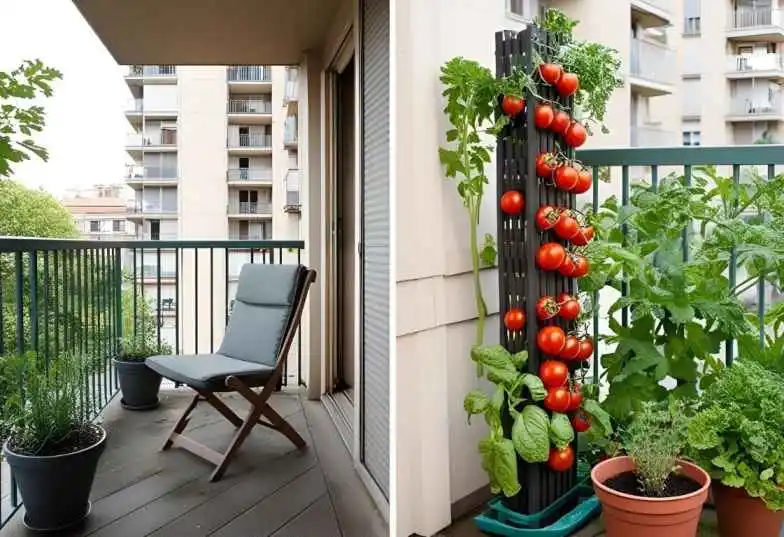Introduction
Balcony vegetables for beginners are the perfect solution for anyone wanting to grow fresh, organic produce without needing a sprawling backyard or acres of farmland. With the right knowledge and approach, your balcony can become a productive mini-farm that supplies fresh, organic vegetables right to your kitchen. Whether living in a cramped city apartment or simply wanting to make the most of your outdoor space, balcony vegetables for beginners offer an accessible entry point into sustainable living and self-sufficiency. The Ultimate Guide to Creating a Thriving Balcony Garden

The beauty of balcony vegetables for beginners lies in their simplicity and immediate rewards. Unlike traditional gardening, you have complete control over your growing environment, from soil quality to watering schedules. This controlled environment makes it easier for beginners to succeed, as you can closely monitor your plants’ progress and quickly address any issues that arise. Plus, there’s something deeply satisfying about harvesting tomatoes, herbs, or lettuce that you’ve nurtured from seed on your balcony, knowing exactly how they were grown without harmful pesticides or chemicals. Need inspiration? Check out Cornell’s Home Gardening Guide for beginner-friendly resources.
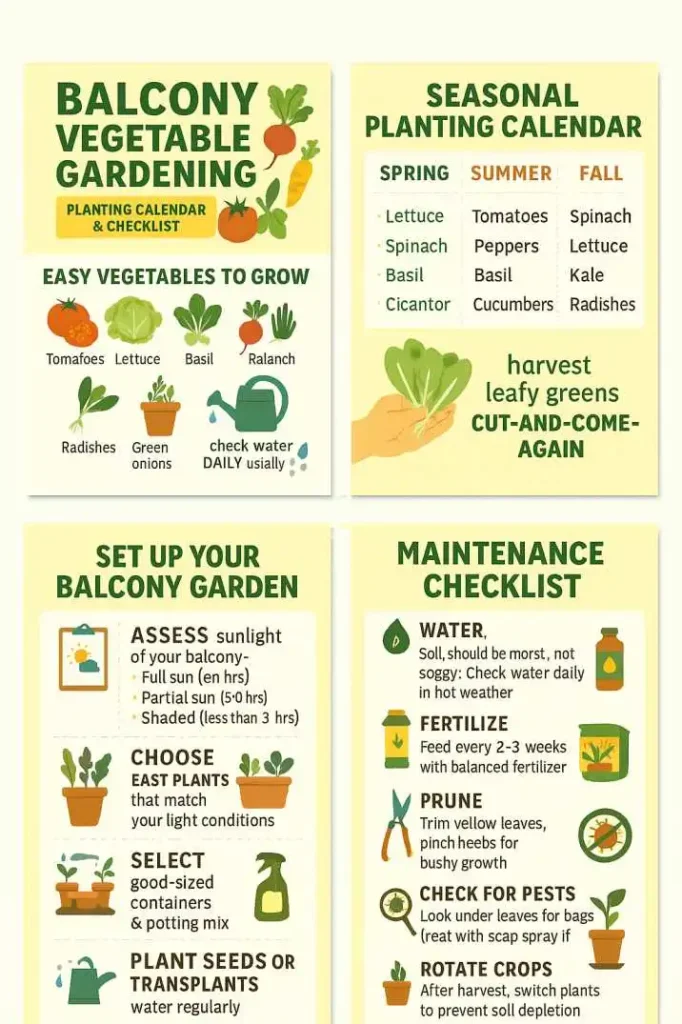
Table of Contents
Why Choose Balcony Vegetable Gardening?
Space Efficiency and Accessibility
Balcony gardening maximizes limited space through vertical growing techniques and compact varieties specifically bred for container cultivation. Modern urban dwellers are discovering that even a modest balcony can yield surprising amounts of fresh produce throughout the growing season. Unlike ground-level gardens, balcony gardens are easier to maintain since they’re at a comfortable working height, reducing the need for bending and kneeling.
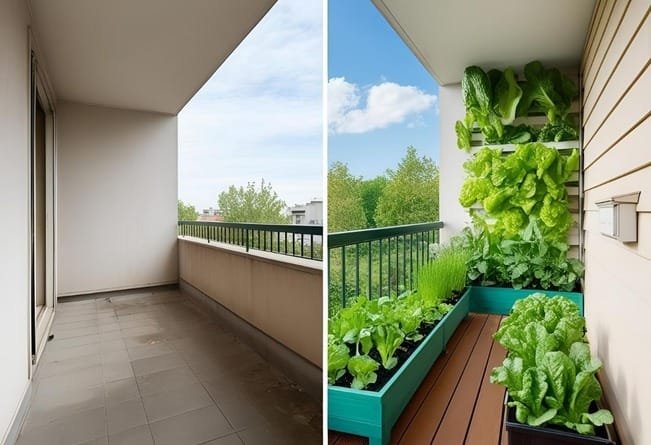
Environmental and Health Benefits
Growing your vegetables significantly reduces your carbon footprint by eliminating transportation costs and packaging waste associated with store-bought produce. You’ll know exactly what goes into your food, avoiding synthetic pesticides and fertilizers while ensuring maximum nutritional value through harvest-to-table freshness. Studies show that homegrown vegetables can contain up to 50% more vitamins and minerals compared to commercially grown produce that may sit in storage for weeks. Discover how urban gardening contributes to sustainability at the Royal Horticultural Society.
Cost-Effective Food Production
While the initial setup requires some investment in containers and soil, balcony gardens quickly pay for themselves. A single tomato plant can produce 10-15 pounds of fruit over a season, while a packet of lettuce seeds costing less than $3 can provide months of fresh salads. The cost savings become particularly significant for expensive organic produce and fresh herbs that typically cost $2-4 per small package at grocery stores.
Real Garden Stories
Real Garden Story: From Clothesline to Crops in Mumbai
My 4×6 ft balcony once held just a clothes drying rack. Six months later, it’s a lush mini-farm with basil, tomatoes, and green chilies that slashed my grocery bill by 30%.
Essential Requirements for Balcony Vegetable Gardens
Sunlight Assessment and Plant Selection
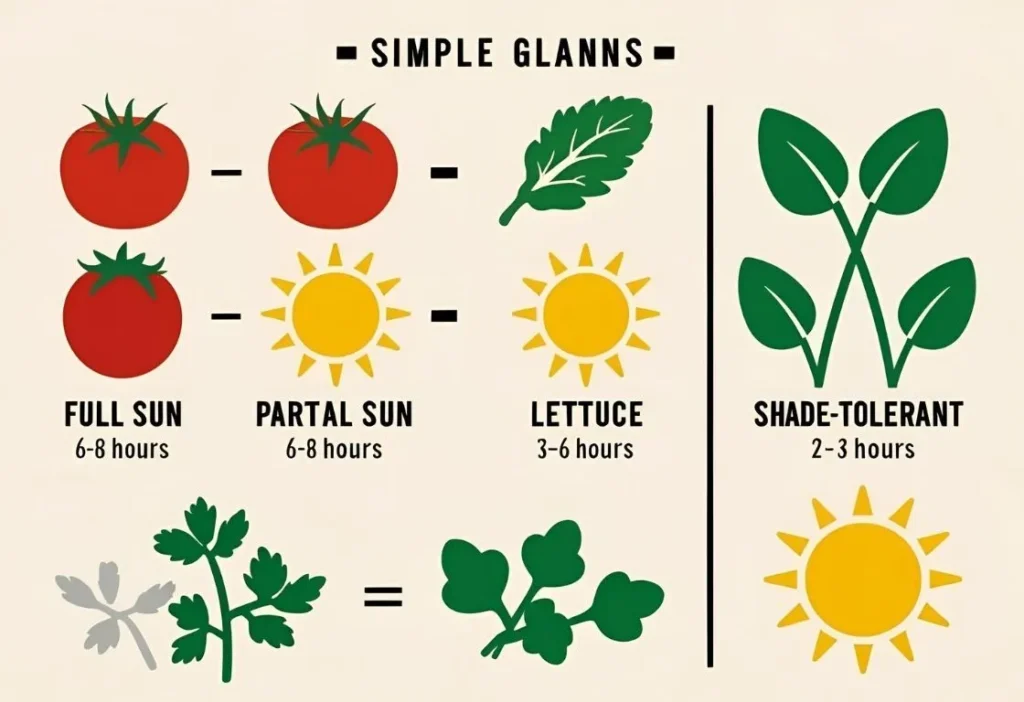
Most vegetables require 6-8 hours of direct sunlight daily for optimal growth and fruit production. Before selecting plants, observe your balcony throughout the day to determine peak sun exposure times. South-facing balconies typically receive the most consistent sunlight, making them ideal for sun-loving crops like tomatoes, peppers, and cucumbers. East and west-facing balconies receive moderate sunlight for leafy greens, herbs, and root vegetables.
If your balcony receives less than 6 hours of direct sun, don’t despair. Many vegetables, including lettuce, spinach, kale, and most herbs, thrive in partial shade. Consider using reflective surfaces like mirrors or aluminum foil to redirect additional light to your plants, or invest in LED grow lights to supplement natural sunlight during shorter days.
Container Selection and Drainage
Proper container selection directly impacts plant health and productivity. Vegetables need adequate root space, so container depth varies by plant type: shallow-rooted crops like lettuce require 6-8 inches, while deep-rooted plants like tomatoes need containers at least 18-20 inches deep. Width is equally important, as it determines how many plants can be grown together.
Drainage remains the most critical factor in container gardening success. Every container must have multiple drainage holes to prevent waterlogged soil, which leads to root rot and plant death. Place saucers under containers to protect balcony surfaces, but ensure water doesn’t accumulate. Consider using pot feet or blocks to elevate containers slightly, improving airflow and drainage. For expert guidance on container sizes and soil types, visit the University of Illinois Extension’s Container Gardening Guide.
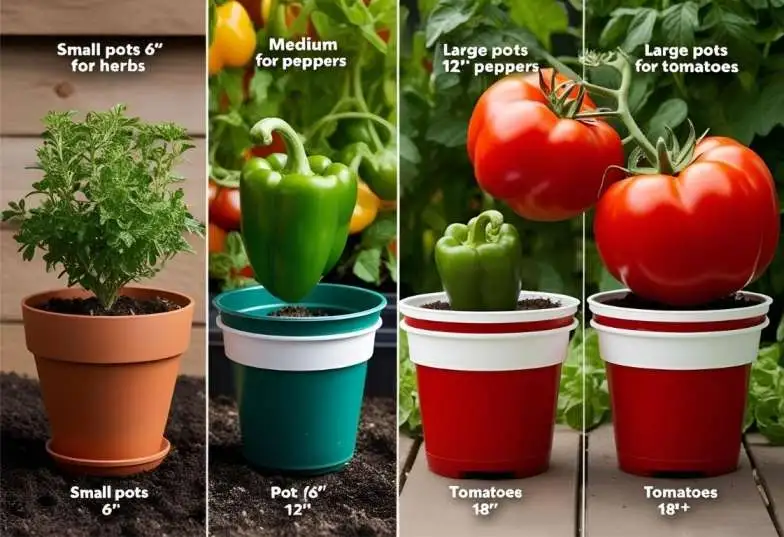
Complete Setup Timeline & Shopping Guide
Planning Your Balcony Garden Success from Day One
Starting a balcony garden becomes manageable with a clear roadmap. Proper preparation prevents costly mistakes and ensures you have everything ready when planting season arrives. A structured timeline helps beginners avoid overwhelm while setting realistic expectations for each phase.
Week 1-2: Assessment and Planning Phase
Conduct a thorough sunlight assessment by photographing your balcony at different times throughout the day. Measure your space and check for weight restrictions. Research your local frost dates and growing zone to determine optimal planting windows. Create your plant list based on your family’s eating preferences and balcony conditions.
Budget $15-25 for planning materials, including a measuring tape, notebook, and pH testing strips. This small investment prevents larger expenses later by helping you choose suitable plants and containers.
Week 3-4: Infrastructure and Supply Acquisition
Purchase containers, potting soil, and basic tools during this phase. Budget $75-125 for a starter garden supporting 4-6 vegetable varieties. Quality potting mix costs $8-12 per bag, containers range $10-30, and drainage saucers cost $3-8 each.
Essential tools include a hand trowel ($8-15), watering can ($12-20), and pruning shears ($10-18). Add basic fertilizer and organic pest spray for another $15-25. Set up containers with drainage and fresh soil during week 4, allowing everything to settle before planting.
First 30 Days After Planting: Milestone Markers
The first month determines long-term success. Check daily for germination signs—lettuce and radishes sprout within 5-7 days, while tomato transplants show new growth in 10-14 days. By day 15, fast-growing crops should be large enough for micro-green harvests.
The 30-day mark is your first major checkpoint. Healthy, established plants with vigorous growth indicate you’ve mastered the fundamentals and can confidently expand your garden in future seasons.
Best Balcony Vegetables for Beginners
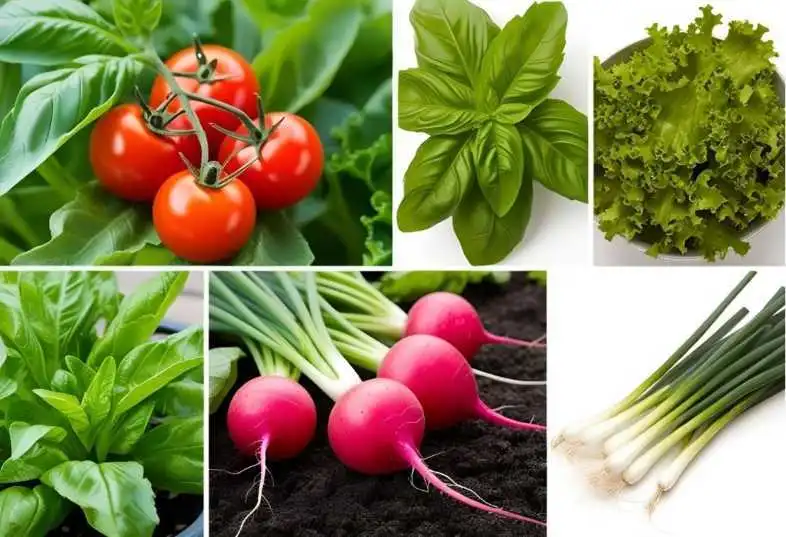
Easy-to-Grow Leafy Greens
Lettuce, spinach, and kale top the list of beginner-friendly balcony vegetables due to their fast growth cycles and minimal space requirements. These crops can be harvested multiple times throughout the season using the “cut and come again” method, where you harvest outer leaves while allowing the center to continue growing.
Lettuce varieties like buttercrunch, romaine, and leaf lettuce mature in just 45-60 days and can be grown in containers as shallow as 6 inches. Plant seeds every 2-3 weeks for continuous harvests throughout the growing season. Cool-season crops like lettuce prefer some protection from intense afternoon sun, making them perfect for partially shaded balconies.
Spinach provides exceptional nutritional value and grows quickly in cool weather. Plant in early spring and again in late summer for best results, as hot weather causes spinach to bolt (go to seed) prematurely. Baby spinach leaves can be harvested in just 30 days, while full-size leaves are ready in 45 days. Learn more about growing vegetables in containers at Gardening Know How.
Quote:
“I never imagined growing spinach and tomatoes in pots would be so easy. Now I pick them fresh for lunch every day!” – Arjun D., Bengaluru
Productive Fruiting Vegetables
Cherry tomatoes offer the best success rate for beginning balcony gardeners. Compact determinate varieties like ‘Patio’, ‘Tumbling Tom’, or ‘Sweet ‘N’ Neat’ are specifically bred for container growing and produce abundant crops in limited space. These plants typically reach 12-18 inches in height and don’t require extensive staking or pruning. Check out this Container tomato guide from the RHS for more.

Peppers adapt exceptionally well to container culture and come in varieties ranging from sweet bell peppers to spicy chilies. Compact varieties like ‘Lunch Box’, ‘Mini Belle’, or ‘Basket of Fire’ produce full-size peppers on dwarf plants perfectly suited for balcony growing. Peppers are generally easier to grow than tomatoes, requiring less water and being more resistant to common plant diseases.
Space-Saving Herbs and Aromatics
Basil serves as both a culinary herb and a companion plant that may help deter pests from nearby vegetables. Pinch flower buds regularly to encourage leaf production and prevent the plant from going to seed. A single basil plant can provide fresh leaves throughout the entire growing season with proper care.
Chives, parsley, and cilantro offer continuous harvests and can tolerate partial shade conditions. These herbs require minimal space and can be grown in smaller containers alongside other plants. Regular harvesting promotes new growth, ensuring a steady supply of fresh herbs for cooking.
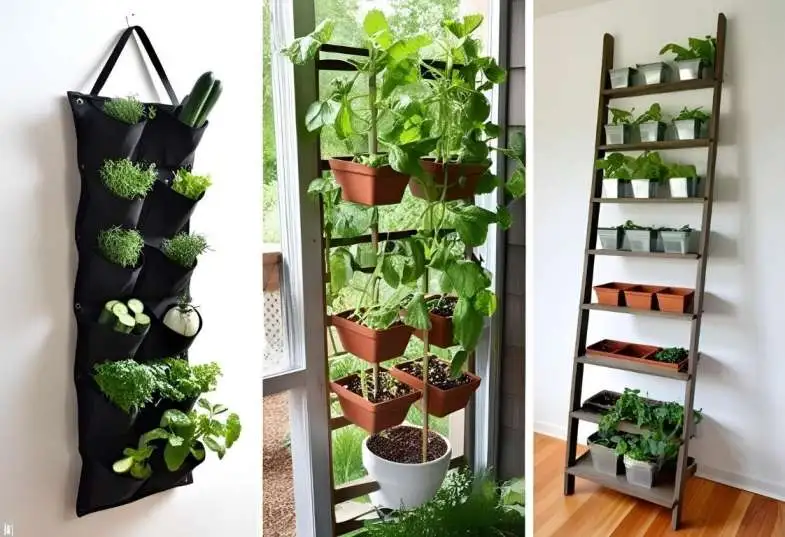
Setting Up Your Balcony Garden
Soil and Nutrition Management
Quality potting soil forms the foundation of successful balcony gardening. Never use garden soil in containers, as it’s too heavy and doesn’t drain properly in confined spaces. Choose a high-quality potting mix formulated for containers, providing proper drainage while retaining adequate moisture. Explore this detailed guide on Soil mix for containers by The Spruce.
Enhance your potting mix with compost to improve soil structure and provide slow-release nutrients. A mixture of 70% potting soil and 30% compost creates an ideal growing medium for most vegetables. Consider adding vermiculite or perlite to improve drainage in heavy potting mixes, especially important for Mediterranean herbs that prefer drier conditions.
Container vegetables require regular fertilization since nutrients leach out with frequent watering. Use a balanced, water-soluble fertilizer every 2-3 weeks, or incorporate slow-release fertilizer granules into the soil at planting time. Organic options like fish emulsion or compost tea provide gentle nutrition without the risk of burning sensitive plant roots.
Watering Systems and Techniques
Consistent moisture levels are crucial for healthy vegetable production, but overwatering kills more container plants than any other factor. Check soil moisture daily by inserting your finger 1-2 inches into the soil; if it feels dry, it’s time to water. Most balcony vegetables need watering every 1-2 days during hot weather, but this varies based on container size, plant type, and weather conditions.
Drip irrigation systems or self-watering containers can automate watering and provide more consistent moisture levels. These systems are particularly valuable for frequent travelers or during hot summer periods when daily watering becomes essential. Hand watering works well for small gardens, but ensure you water thoroughly until water drains from the bottom holes.
My Balcony Wins & Fails
- Win: My ‘Tumbling Tom’ tomato plant yielded 4kg of fruit in 90 days.
- Fail: My first basil batch died from overwatering—lesson learned: use cocopeat and check the soil before watering!
Maintenance and Care Tips
Pest Management and Disease Prevention
Balcony gardens typically experience fewer pest problems than ground-level gardens, but common issues include aphids, spider mites, and whiteflies. Companion planting with herbs like basil, marigolds, or nasturtiums can naturally deter many pests while adding beauty and diversity to your garden. For organic pest control, Neem Oil Benefits from GrowNYC offers helpful advice.”
Inspect plants weekly for signs of pest activity or disease, catching problems early when they’re easier to manage. Neem oil provides an organic solution for the most common balcony garden pests and can be applied safely up to harvest time. Remove any yellowing or diseased leaves immediately to prevent problems from spreading to healthy parts of the plant.
Good air circulation prevents many fungal diseases common in humid environments. Space containers appropriately and consider using small fans during particularly humid periods. Avoid watering leaves directly; instead, focus water at the soil level to reduce moisture on plant surfaces where diseases develop. Use this Companion planting chart from the Old Farmer’s Almanac to naturally manage pests.
Urban Gardeners Spotlight
Priya K., Bangalore IT Professional
In just one monsoon season, Priya’s 8×4 ft balcony produced over 15kg of spinach, chilies, and tomatoes—enough to share with neighbors and family. Her secret? “Use vertical bamboo shelves to triple your grow space.”
Rohan M., Delhi Architect
Rohan built a herb garden with scrap wood pallets on his 12th-floor balcony. Despite the 47°C heat, his mint and thyme survived under shade cloth. “Herbs love consistent watering at sunset,” he notes.
Seasonal Planning and Succession Planting
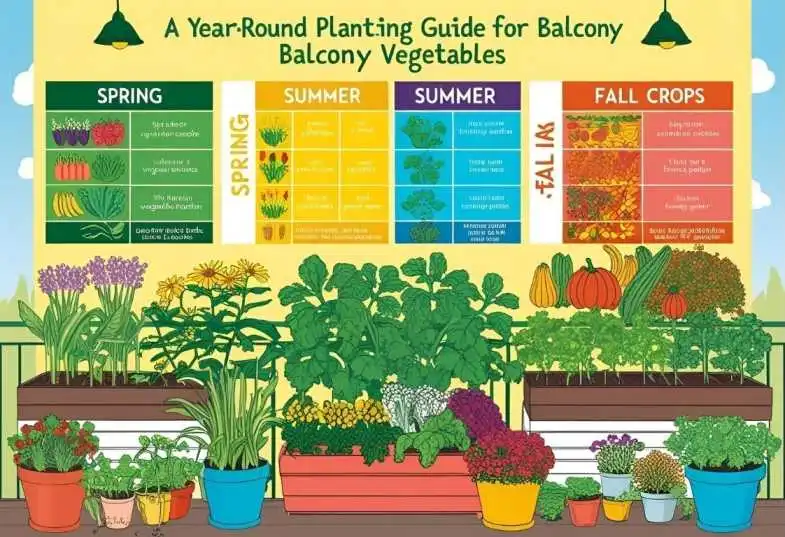
Plan your planting schedule based on your local climate and specific vegetable requirements. Cool-season crops like lettuce, spinach, and peas should be planted in early spring and again in late summer for fall harvests. Warm-season vegetables like tomatoes, peppers, and basil need warm soil temperatures and should be planted after the last frost date in your area.
Succession planting ensures continuous harvests throughout the growing season. Plant new lettuce seeds every 2-3 weeks, stagger herb plantings, and replace finished crops with new varieties suitable for the changing season. This technique maximizes your balcony’s productivity while providing diverse vegetables for your table.
Explore Vertical garden kits on Amazon to maximize your space.
Maximizing Your Harvest
Vertical Growing Techniques
Make the most of limited balcony space through vertical growing methods that multiply your growing area without requiring additional floor space. Trellises and climbing supports work perfectly for vining crops like cucumbers, pole beans, and indeterminate tomatoes. Wall-mounted planters and hanging baskets utilize vertical wall space for trailing crops like cherry tomatoes or cascading herbs.
Layered planting combines plants with different heights and growth habits in a single container. Plant tall crops like tomatoes or peppers in the center, surround them with medium-height plants like basil, and edge containers with trailing crops like nasturtiums or cherry tomatoes. This technique creates living sculptures while maximizing productivity per square foot.
Harvesting and Storage
Proper harvesting techniques encourage continued production and ensure peak flavor and nutrition. Harvest leafy greens in the morning when they’re crisp and full of moisture, cutting outer leaves while leaving the growing center intact. Pick tomatoes when they show the first color and allow them to ripen indoors for better flavor and texture.

Preserve your harvest through simple techniques like freezing herbs in ice cubes, drying herbs for winter use, or fermenting vegetables for extended storage. Even small balcony gardens can produce surplus crops during peak season, and preservation extends the benefits of your gardening efforts throughout the year.
Beginner Mistakes I Made
Starting your first balcony garden is exciting—but you’re bound to make a few blunders (I did too!). Here are some beginner mistakes I made and what I learned from them:
- Overcrowding containers: I planted too many seeds in one pot. The plants fought for space, and most didn’t thrive. Now, I follow the “1-plant-per-pot rule” for bigger harvests.
- Watering too much: My basil looked sad within two weeks. The culprit? Overwatering! I learned to check the soil with my finger before every watering, and switched to cocopeat for better drainage.
- Misjudging sunlight: I thought my balcony got plenty of sun, but it turns out only the morning light reached it. My spinach wilted in the afternoon heat. Now I track sunlight with photos every few hours to match plants correctly.
- Ignoring drainage: Some of my earliest containers didn’t have holes. Big mistake—water pooled at the bottom and ruined the roots. Since then, I drill holes and use bricks to raise pots for airflow.
- Skipping labels: I forgot which pot had what seeds. Once everything sprouted, I couldn’t tell coriander from parsley! Now, I use popsicle sticks and permanent markers to label every pot clearly.
Conclusion: Your Journey to Balcony Garden Success
Starting a balcony vegetable garden represents more than just growing food—it’s a step toward sustainable living, self-sufficiency, and reconnecting with the natural world from your urban environment. The satisfaction of harvesting fresh tomatoes, crisp lettuce, or fragrant herbs from your balcony creates a deep sense of accomplishment while providing the freshest, most nutritious produce possible.
Remember that gardening is a learning process, and every season brings new experiences and knowledge. Start small with easy-to-grow vegetables like lettuce and herbs, then gradually expand your garden as you gain confidence and experience. Don’t be discouraged by initial setbacks—even experienced gardeners face challenges with weather, pests, or plant diseases.
Your balcony garden will evolve with your needs and interests, potentially inspiring friends and neighbors to start their own growing spaces. The environmental benefits multiply as more people embrace urban agriculture, creating communities of gardeners sharing knowledge, seeds, and harvests. Learn how EPA Urban Gardening can reduce your carbon footprint.
Ready to transform your balcony into a productive paradise? Start planning your garden today by assessing your space, selecting your first vegetables, and gathering the basic supplies you’ll need. What vegetables are you most excited to grow in your new balcony garden? Share your plans and questions in the comments below—the gardening community is always eager to help fellow growers succeed!
Download the Balcony Garden Starter Kit [Infographic + Quiz PDF]
Frequently Asked Questions (FAQs)
Q. What vegetables grow best on a balcony?
A. Some of the best vegetables for balcony gardening include lettuce, spinach, kale, cherry tomatoes, peppers, radishes, and herbs like basil, parsley, and chives. These are compact, fast-growing, and thrive in containers.
Q. How much sunlight do balcony vegetables need?
A. Most vegetables require 6–8 hours of direct sunlight per day. South-facing balconies are ideal, but leafy greens and herbs can tolerate partial shade and still produce well.
Q. Can I grow vegetables on a shaded balcony?
A. Yes, you can! Vegetables like lettuce, spinach, kale, arugula, and most herbs grow well in partial shade. Reflective surfaces or LED grow lights can help supplement natural light in low-light areas.
Q. What size containers do I need for balcony gardening?
A. Container size depends on the vegetable:
Leafy greens: 6–8 inches deep
Tomatoes and peppers: 18–20 inches deep
Herbs: 6–10 inches deep
Always ensure containers have good drainage holes.
Q. How often should I water my balcony vegetables?
A. Most vegetables need watering every 1–2 days, especially in hot weather. Check soil moisture by sticking your finger 1–2 inches deep—if it’s dry, it’s time to water. Avoid overwatering to prevent root rot.
Q. What’s the easiest vegetable to grow in a balcony garden?
A. Lettuce is one of the easiest and most rewarding vegetables for beginners. It grows quickly, requires minimal space, and allows for continuous harvests using the “cut and come again” method.
Q. Can I grow vegetables in recycled containers?
A. Absolutely! You can repurpose plastic tubs, buckets, old pots, or crates as long as they have proper drainage. Be sure to clean and sanitize them before planting.
Q. Can balcony gardening save money?
A. Yes! While the initial setup has some costs, growing vegetables like tomatoes, lettuce, and herbs can save hundreds of dollars annually, especially when replacing store-bought organic produce.
Know more about “Balcony Vegetables Gardening” Download Our Checklist
Want to learn more about Balcony Garden?
- The Ultimate Guide to Creating a Thriving Balcony Garden – Check
- Easy Balcony Vegetables for Beginners: What to Grow First → will be coming to our site soon!
About the Author
Soumen Chakraborty is an environmental writer who is passionate about sustainable solutions. He has researched and written about environmental issues for two years, breaking complex topics into practical, actionable insights.
Loved these Balcony garden tips?
Share this with your friends on Facebook, use #MyBalconyGarden, Pinterest, or Twitter, and spread the green!
Disclosure: As an Amazon Associate, I earn from qualifying purchases at no extra cost to you. Your support helps keep this site running. Thank you!
Ready to Start Your Balcony Garden Journey?
Begin with a simple sunlight assessment this week. Take photos at different times of day to create your sunlight map, then return to this guide to select your perfect plants and containers.
Share your balcony garden progress in the comments below!”
Show us your progress! Tag @greenglobe25.in on Instagram or use #MyBalconyGarden to get featured.

